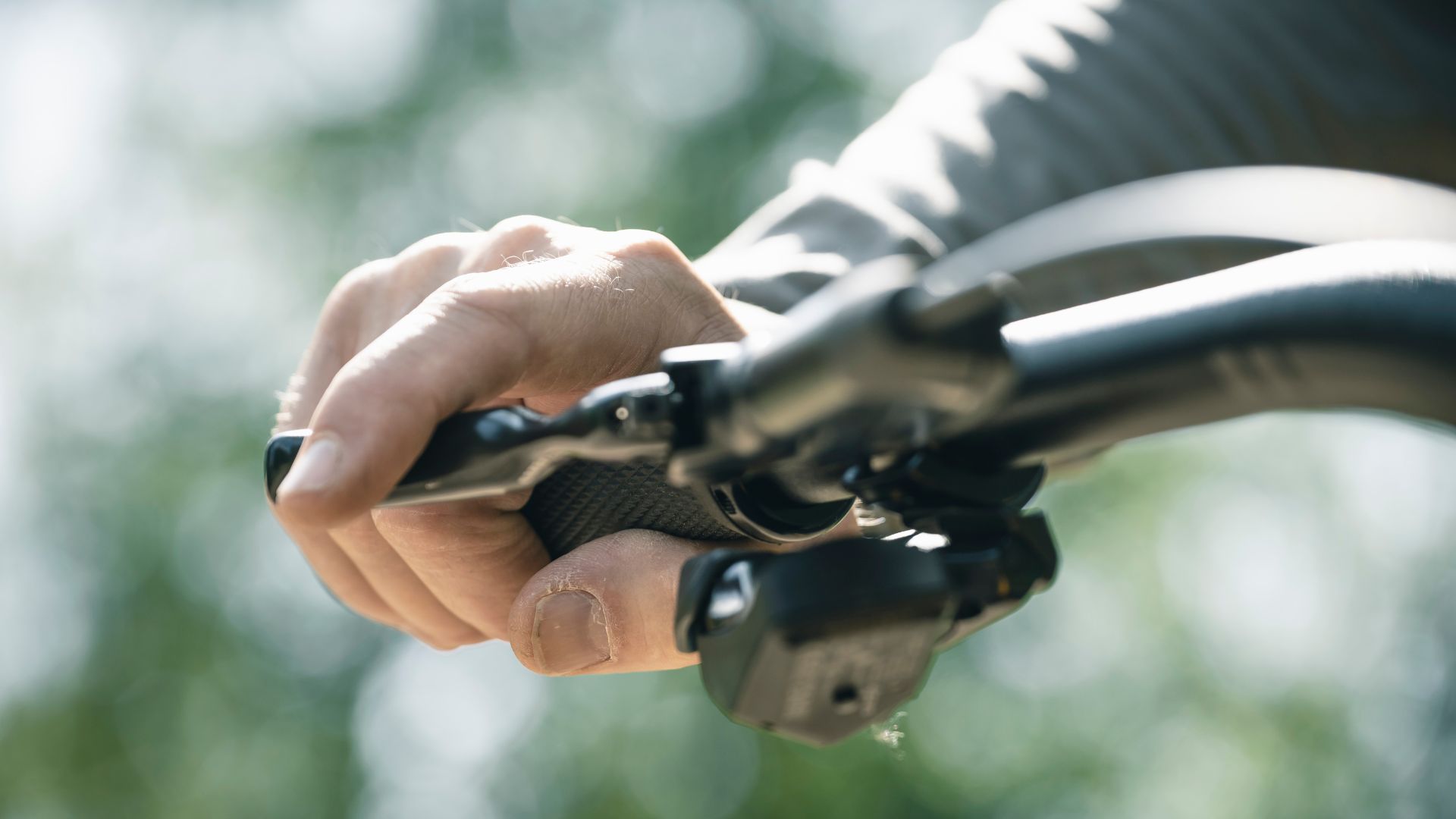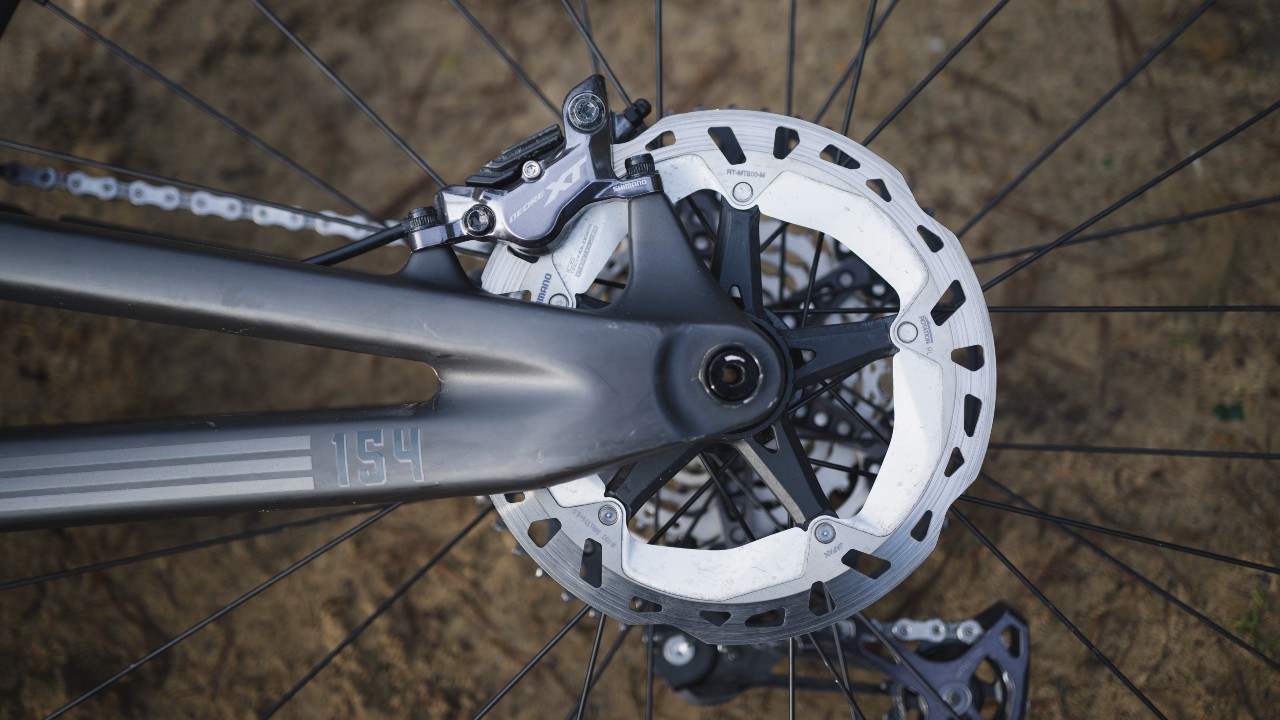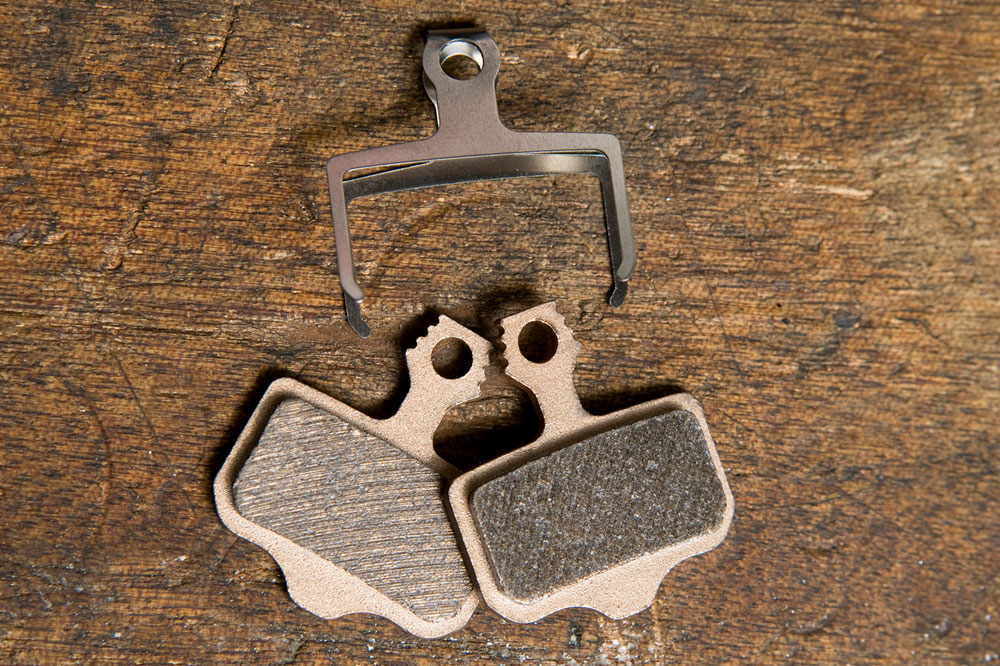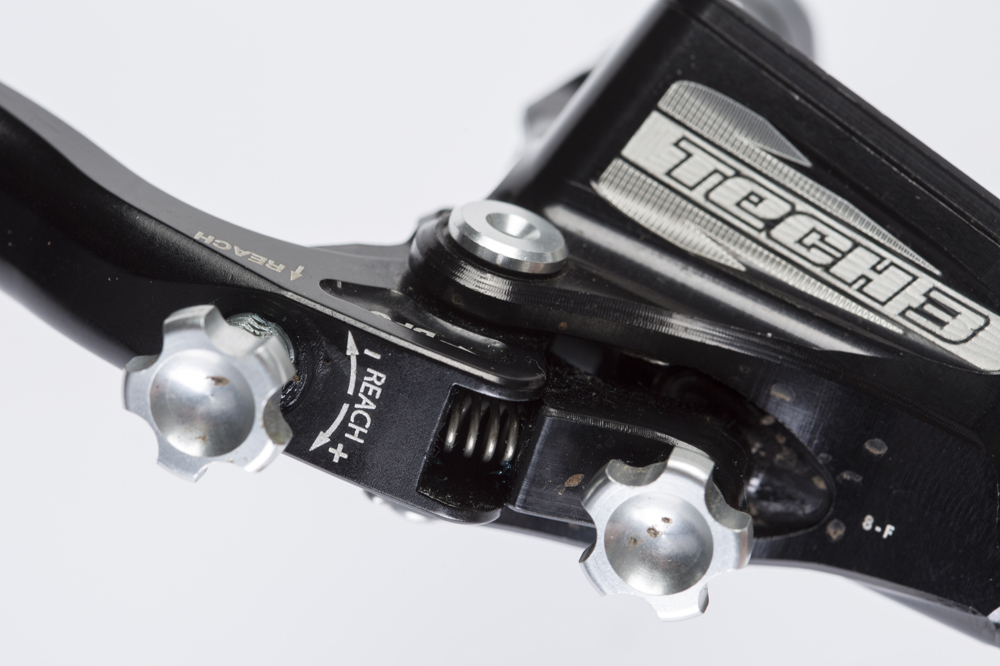We've tried and tested the very best mountain bike disc brakes, covering budget, trail, e-bike and four-piston options. Don't start stopping until you've read this.
Power is nothing without control and the best mountain bike disc brakes offer both. The power you need to control your speed, and brake with one finger to reduce fatigue and allow better control and handling. We’ve extensively tested the latest hydraulic disc brakes on the market head-to-head, and only the best of the best make it to this guide.
Best MTB disc brakes – quick list
- Best value disc brake – Shimano Deore M6100
- Best lightweight XC disc brake – Hope Pro XCR Pro E4
- Best gravity or e-bike disc brake – SRAM Maven

Shimano has nailed the price and performance balance with the Deore brake.
1. Shimano Deore M6100
Best value disc brake
Weight: brake 291g, rotor 199g | Rotors: 160, 180, 203 and 220mm | Rating: 10/10
Reasons to buy:
- Impressive power and modulation
- Reliable
- Great value for money
Reasons to avoid:
- Levers can rattle slightly
- Fiddly set up
Shimano’s Deore brake punches well above its weight, with a bargain price, buckets of power, and a premium feel. There’s a two-piston caliper that beautifully balances weight with power, and a stubby, one-finger lever that feels nice to pull with a light action and good modulation.
Although the brake comes stock with organic pads, you can upgrade these to metal sintered for better wear life and stopping power in the wet. The build quality and finish is excellent, and Deore brakes just seem to go on working perfectly with minimal maintenance. A great product at a brilliant price.
Read our full test review of the Shimano Deore M6100

Hope lets you mash up its lever and calipers, and this XCR / Pro E4 frankenbrake is a wicked combo for lightweight trail bikes.
2. Hope XCR Pro E4
Best lightweight four-piston disc brake
Weight: brake 229g (front) | Rotors: 180, 200mm | Rating: 9/10
Reasons to buy:
- Impressive power-to-weight ratio
- Light lever feel with accurate modulation
- Excellent serviceability and UK support
- Multiple colour options
- Easy-fit hinged clamp
Reasons to avoid:
- No bite point adjust
- Noisy in some situations
- Less power than Hope’s Tech 4 E4 brake
Hope’s minimalist XCR lever started out mated to an X2 twin-pot brake caliper, making it ideal for proper cross-country applications. Now there’s the option to buy it paired with the more powerful Hope E4 four-pot brake caliper. Available in six colour options, the XCR lever sports a reach-adjustable carbon blade and titanium hardware but lacks the bite point adjustment that’s standard on the Tech 4 lever.
In testing, we found the XCR Pro E4 brake to be an excellent balance of weight, power and control – making this a sound choice for riders who like to go hard on the climbs and the descents. An ideal upgrade for one of the best down-country bikes. Considering the brakes are machined, anodised and assembled in the UK, with the unrivalled spares backup you get from Hope, we feel the pricing is very competitive with other top end brakes.
Read our full review of the Hope XCR Pro E4

SRAM’s Code RSC disc brakes are smooth and adjustable.
3. SRAM Code RSC
Best blend of power, lever feel and adjustability
Weight: brake 318g, rotor 205g | Rotor size: 160, 180, 200, 220mm | Rating: 9/10
Reasons to buy:
- Powerful
- Excellent feel
- Multi-adjustable for lever reach and bite point
- Wide range of rotor and pad options
Reasons to avoid:
- Pistons can get sticky
- Lever pivot bolts can come loose
- Expensive in this RSC spec
The premium-spec Code RSC was a high-scoring brake in our last group test, receiving a rating of 9/10. Before the arrival of the Maven, the Code was SRAM’s most powerful disc brake, aimed at DH and enduro riding, with traits that also make it ideal for controlling the extra weight of an e-bike. It has four-pistons, larger pads and more oil volume compared to its trail-orientated stablemate, the (now discontinued) SRAM G2. Our review highlighted the Code’s incredibly light lever action and the way the braking power builds progressively, so you don’t have to pull too hard. And there always feels like there’s some power in reserve.
At over £300 a wheel (when tested in 2022), we couldn’t give the RSC model top marks for value, but the feel and power are outstanding and there’s a cheaper Code R model that forgoes the Contact Point adjuster and bearing lever pivot. Newer Stealth models have now joined the Code lineup, using an all-new lever body design that brings the hose closer to the bar, for a sleeker and tidier look.
Read our review of the SRAM Code RSC

The Hope Tech 3 V4 caliper is a work of machine art.
4. Hope Tech 3 V4
Best disc brakes for adjustability
Weight: brake 265g, rotor 173g | Rotors: 160, 180, 183, 200, 203, 220, 225mm | Rating: 9/10
Reasons to buy:
- Adjustable and indexed reach
- Easy set up
- Lightweight
- Powerful
Reasons to avoid:
- Stiff reach adjustment
- Too much lever stroke before engagement
This is Hope’s downhill brake with a Tech 3 lever mated to a V4 caliper, but it’s light enough to run on a trail or enduro bike as well as an e-bike. Made in the UK, one of Hope’s main advantages is that everything can be mixed-and-matched, with comprehensive spares back up. Oh, and with loads of colours available, you can ensure your brakes match your bike perfectly.
Hope’s redesigned brake lever has reach and bite point adjustment via two machined dials, so you can really tune the lever feel to your preference. While the big four-piston caliper provides loads of stopping power and the light lever action lets you modulate that power with perfect control. Overall, this is a lightweight, powerful, user-friendly disc brake, that’s also great value for money.
Read the full Hope Tech 3 V4 disc brake review

Clarks Clout1 is the best wallet-friendly option.
5. Clarks Clout1
Best disc brake under £50
Weight: brake 307g, rotor 190g | Rotor size: 160 and 180mm | Rating: 8/10
Reasons to buy:
- Unrivalled budget brake
- Reasonably powerful
- Easy to set up and bleed
Reasons to avoid:
- Not the nicest lever feel or modulation
At £29 the Clout1 is just jaw-droppingly cheap, and although it feels a little wooden and has limited rotor options, it’s the perfect brake if you’re looking to upgrade from a mechanical disc or put together a budget frame build. Performance-wise the Clout1 is a good brake for the money, with surprisingly good power.
So just where exactly has Clarks cut corners? Well, the clamp is single bolt so you have to remove your grips (and dropper remote) to slide the brake off the bar. And the reservoir design is simple and side-specific, so you can’t flip it over to use on the left/right without unplugging the hoses and rebleeding. There’s no bite point adjust (often the case on non-megabucks brakes) and the lever blade isn’t the most ergonomically sophisticated, but the Clout1 scores where it counts: power, reliability and consistency.
Read our full test review of the Clarks Clout1

Hayes Dominion A4 uses a clever alignment system for easy drag-free adjustment.
6. Hayes Dominion A4
Best brakes for easy adjustment and set-up
Weight: brake 306g, rotor 188g | Rotor size: 180 and 203mm | Rating: 9/10
Pros:
- Great value and quality
- Dialled reach adjustment
- Comfortable
- Fine-tuneability
Cons:
- No bite point adjustment
To simplify setting up the caliper drag-free, Hayes has created the clever Crosshair centring system, and it’s standard on the Dominion brake. Basically it lets you tweak the angle of the caliper relative to the disc and lock it in place. There’s also loads of pad clearance to the rotor, so there are no excuses for rubbing brakes with the Dominion.
Hayes has also achieved a light lever action with no slop, thanks to a cartridge pivot bearing, and there’s loads of power and natural modulation. The main complaint is the weight, but overall it’s a really good brake that’s easy to live with.
Read our full test review of Hayes Dominion A4
Best gravity and e-bike disc brakes
These brakes are built to deal with the extra mass of electric mountain bikes and the higher speeds and steep terrain of enduro, downhill, or lift-assisted riding. If you like a really powerful brake, prefer steeper terrain where stronger braking power is required, or are a heavier rider, you’ll feel the benefit of these confident stoppers.

SRAM’s Maven Ultimate Expert is built big in all directions, and boasts an impressively solid and reliable feel.
1. SRAM Maven Ultimate
Most powerful disc brake for e-bikes and gravity riding
Weight: brake: 362g (rear, claimed) | Rotor size: 180, 200, 220mm | Rating: N/A
Reasons to buy:
- Bags of power
- Superb modulation
- Light action
- Solid lever feel when really going for it
- Longer service intervals
Reasons to avoid:
- Heavy compared to a SRAM Code
- Ugly caliper
- Initial breakaway force at the lever is high
- Expensive in this Ultimate Expert spec
Launched in 2024, the Maven is designed for use on the best DH bikes, freeride, enduro, and e-bikes. It brings new levels of power and control to the SRAM range and like the DB8 models, uses mineral oil rather than DOT brake fluid. This Maven Ultimate Expert kit comes in the custom red splash anodised finish and includes, four rotors, two sets of organic pads, two sets of sintered metal pads, a bleed kit, rotor bags, and brackets and mounts.
We have yet to conduct a long term test but first impressions are extremely positive and so far the Maven Ultimate Expert has been impressively silent, consistent and absolutely rock solid. Editor Danny Milner claims this is far and away the best SRAM brake he’s ever used – a big step-up in performance from the Code – and possibly a new benchmark for gravity braking.
Read the full SRAM Maven Ultimate disc brake review

Hope Tech 4/E4 brakes are impressive in many ways
2. Hope Tech 4 E4
Best gravity brakes for colour matching and servicing
Weight: 290g (lever/caliper/hose), floating rotors 178g | Rotors: 160, 180, 183, 200, 203, 220, 225mm | Rating: 9/10
Reasons to buy:
- Excellent modulation and power
- Light lever action
- Hinged lever clamp is easy to use
- Multiple colour options
Reasons to avoid:
- Lever shape has crisp edges that can feel uncomfortable
- New pads didn’t last as long as expected
This all-new Tech 4 is something of a radical departure for Hope, and alongside smaller improvements inside the caliper, represents a totally new brake. The biggest visible change is that the updated lever is considerably longer, bringing a claimed 30% pressure increase compared with the Tech 3. There’s also a new hinged clamp to save weight and integrate better with shifters and dropper remotes.
It’s easy to set up thanks to the tool-free bite point and reach adjustments, and the stopping power is impressive. There’s a broad power band that builds up before really locking the wheel, and it’s easy to control at the lever. Easily Hope’s best brake yet.
Read the full Hope Tech 4 E4 disc brake review

Magura’s MT5 eStop disc brake does not skimp on power.
3. Magura MT5 eStop brake
Best e-bike brake for power and control
Weight: brake 247g, rotor 182g | Rotor size: 160, 180, 203, 220mm | Rating: 8/10
Reasons to buy:
- Solid lever feel
- Good value
Reasons to avoid:
- Fragile construction
- Long bedding in process
Really Magura’s MT5 eStop is just the MT5 with new rotors, but don’t let that make you think it’s nothing special. As with most Magura brakes, it’s really powerful, with impressive modulation and a super-light lever action. The lever does sweep in towards the grip more than typical designs due to the radial piston layout, but as long as you don’t run your levers close to the grip, it’s not a problem. Paired with a big 220mm rotor, this is a serious brake for gravity riders and e-bikes.
Read the full Magura MT5 eStop disc brake review

Other mountain bike disc brakes to consider:
We have tested dozens of SRAM brakes over the years and there have been some standout models that may not be in the current model range but are still worth tracking down. The SRAM Guide RE (or the later generation G2 RE) paired a Guide lever with a DH-rated Code four-pot caliper, which made for a powerful but affordable four-pot disc brake that’s ideal for a hard-hitting trail bike or e-bike. We rated it at 10/10 in our 2019 review.

SRAM’s shiny G2 Ultimate from yesteryear.
SRAM has discontinued its G2 series disc brakes but if you can find the G2 Ultimate at a heavily-discounted price it makes a fine upgrade on a lightweight trail bike. This is an excellent brake, with a lever pivot bearing, oil-slick bolts and a polished finish. We rated it highly, praising its superb modulation, comfortable carbon lever blade and tool-free reach and bite point adjustment. It may not have the low profile lever shape and handlebar-hugging hose of the newer Level Ultimate Stealth brake but it still has a cool aesthetic and premium feel.
The Hope Tech 3 V4 mates the adjustable Tech 3 lever to the V4 four-pot caliper and is listed as Hope’s downhill brake. But don’t let the tag put you off, this is easily light enough to go on a hard-hitting trail bike and would also make a great brake for an e-bike. Hope offers a bewildering array of rotors for the V4; from 140mm to 225mm, floating or fixed, and even different thicknesses. Our testing revealed that there’s plenty of grunt and the lever has such a light action that you can easily modulate the power delivery with one finger.
Combining a one-piece, twin-piston CNC machined caliper with a super lightweight brake lever, the Hope XCR Pro X2 is a disc brake designed for XC and marathon-style riding. We don’t think the Hope XCR looks as classy as a SRAM Level Ultimate or a Shimano XTR, but it undercuts both on price and offers a touch more handlebar clearance. It’s also easy to service and bleed, which if you’re racing every weekend, is an important consideration.
With the latest pads fitted, the Formula Cura 4 is a fantastic four-piston brake. It lacks some headline features of other similarly-priced brakes but the symmetrical split-clamp lever makes the Cura 4 a breeze to swap between UK and European set-ups. The optional Mix Master clamps allow mounting of the shifter and dropper remote directly to the levers too. The Cura 4’s blend of raw power and reliability impressed us and we awarded it a 9/10 rating.
If you’re looking for a great value disc brake that’s compatible with a range of Shimano and SRAM Matchmaker-style shifter mounts then check out the TRP Slate T4 Evo. This four-piston brake is packed with features too – a thicker 2.3mm rotor, sintered pads, a drilled lever blade and tool-free reach adjustment are all standard spec. The Slate T4 Evo may not be a looker, but it’s a no-nonsense disc brake and in testing we found it to be just as powerful as the E-MTB model.

Shimano’s XT is a really versatile brake – if you get a good one.
When working as they should, the Shimano XT M8100 disc brakes are lovely but we had issues with inconsistency in performance over the test period. Paired with Shimano’s Ice Tech rotors and fittings you’re looking at over £200 a wheel for XT (when tested in 2022), which isn’t too bad for a brake of this quality, but what stops it getting a higher rating than 7/10 is the variable performance. Not knowing how the brake is going to feel from one moment to the next can really catch you out.
The Magura MT5 is the entry-level brake in this German brand’s range, but it shares the same forged four-piston caliper and composite lever body as the more expensive MT7 model. However, both front and rear hoses are supplied uncut, so you will need to shorten the front before fitting and that means you’ll also need a dedicated Magura bleed kit. For an entry-level disc brake the Magura MT5 is excellent value and it is lightweight, but our testing revealed that pad life is poor and performance can be inconsistent, especially if you run the levers inboard.
How we tested the best mountain bike disc brakes
As well as drawing on our extensive experience of these brakes on test bikes in a variety of terrain and weather conditions, all of them were tested over the same loop on the same bike to highlight differences in performance. We compared power, modulation, set-up and ergonomics.
Most manufacturers don’t include the cost of rotors or adapters in the overall price of their brakes, so we’ve worked this out for you and included it in the info.
We’ve also weighed all of the brakes and included the weight of a 200mm (or 203mm) rotor and lever/caliper. We have not included the weight of the adapters because, depending on the frame and fork you’re using, they may not be necessary. Factor in around 80-90g for two adapters and all the fixing hardware.

Dropping your heels will mean that you can take a lot of weight through your legs when braking
Best mountain bike disc brakes need to know:
A mountain bike disc brake includes a steel rotor, a rotor caliper (with brake pads inside) and a brake lever. Connecting the system is hosing filled with hydraulic fluid.
In an ideal world you wouldn’t need to use the brakes that often because you’d rail every corner, blitz all the descents like a chainless Aaron Gwin and charge down rooty singletrack quicker than a supercharged pro. However, the majority of use don’t have those skills, we drag the brakes when we’re riding downhill, brake all the way round corners and often comfort brake just because things have gotten too scary. For us really powerful and reliable disc brakes are a must have, because often we’re hanging onto them for dear life.
Thankfully every year disc brakes become more efficient and more powerful, so you can get back into your comfort zone a lot sooner. You also get adjustable reach and bite point, so when you absolutely need to stop on a sixpence, your hands will be in the right place. Brake pads are also harder wearing, which is a good thing with all that stopping you’re having to do and foul weather you’re riding in.

Brake pads come in sintered metal or organic compounds.
Brake pads
Brake pads come in two main compounds – metal sintered or organic. The latter are often fitted to brakes because they’re slightly cheaper, but it you want better stopping and longer life, especially in the wet, you’ll want a metal sintered upgrade.

Independent adjustment for reach and bite point on a Hope brake lever
Reach adjustment
This is the most important adjustment on any brake because it allows you to set the reach (lever spacing) to you hand size. The adjuster will often be an annoyingly hard-to-reach grub screw but some brakes come with small knob that you can adjust by hand.
Bite point adjustment
Technically this adjustment doesn’t move the pads any closer to the rotor but it feels like it. It’s handy adjustment if you want to run you levers inboard. SRAM calls this the Contact Point Adjustment, on Shimano it’s Freestroke.

We like big rotors, we cannot lie
Rotor sizes
The best disc rotors are available in various sizes, but the most common are 160, 180 and 200mm. There’s more mechanical advantage with a bigger diameter rotor and so greater stopping power, as well as more heat dissipation.

Fancy rotors are the icing on the cake not utterly essential
Rotor construction
Standard rotors are cut from stainless steel and heat treated and two-piece designs (including floating rotors) have the steel braking disc surface riveted to an aluminium carrier. This type of rotor is lighter, truer and is far less likely to warp but yep you guessed it – it will cost more.
Adapter
Depending on the mounts on your frame/fork and rotor size you may need to run an adapter. In the past these were included but most manufacturers now sell them separately because why should you pay for something you might not use or maybe they’re just being cheap.

Mounting your shifter directly to your brake lever can free up space on your bars, but also restrict positioning.
Shifter mounts
A MatchMaker style clamp allows the shifter to be bolted directly to the lever. It will be an additional cost but it eliminates the clamp, saves weight and frees up bar space for junk such as lights, computers, phone mounts and the like.
Olive and insert
These are the small components used to fasten the hose into the lever. Spares are included in the box because if you shorten the hose you will need to replace them.















